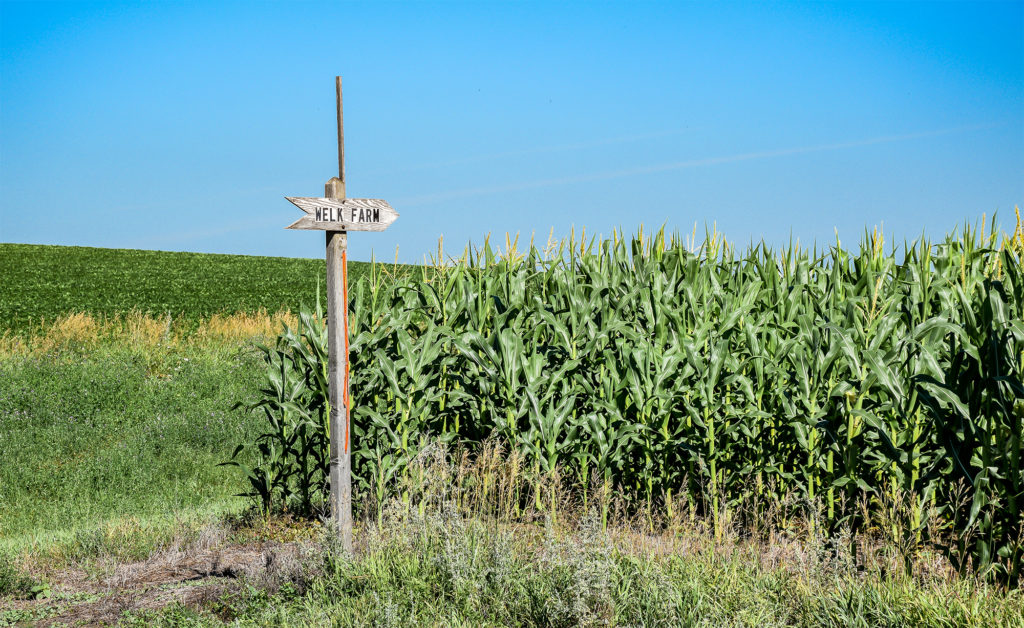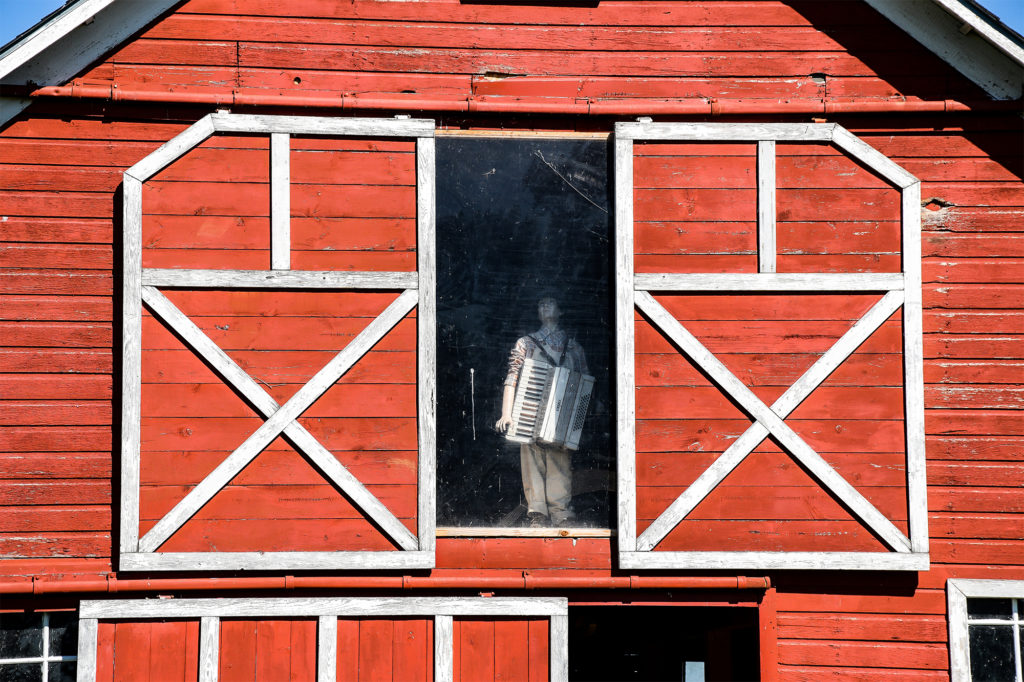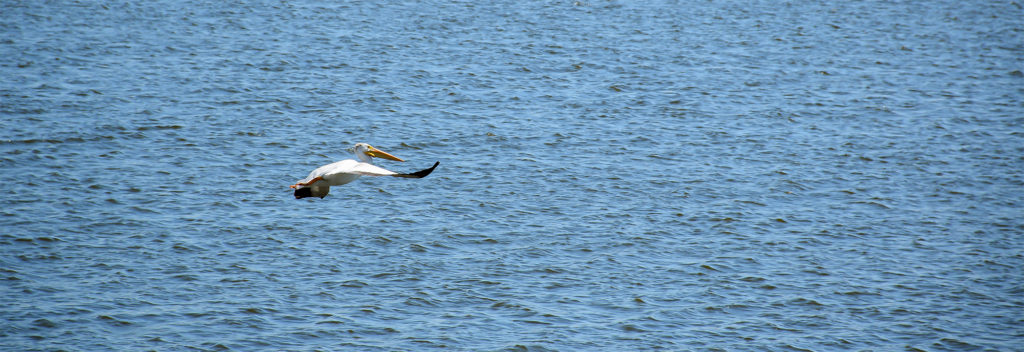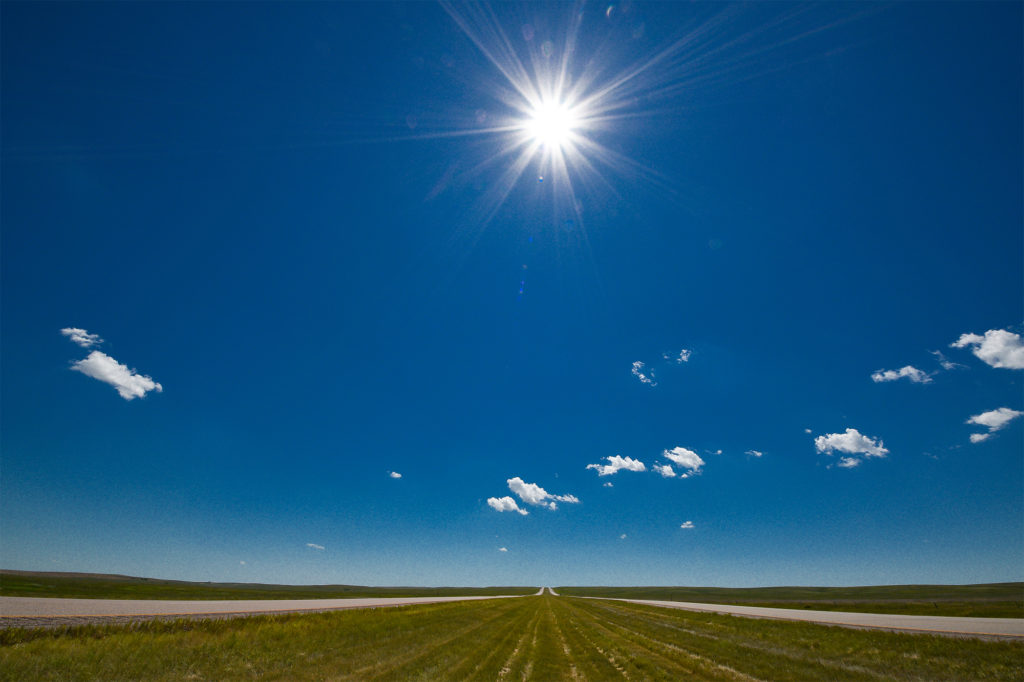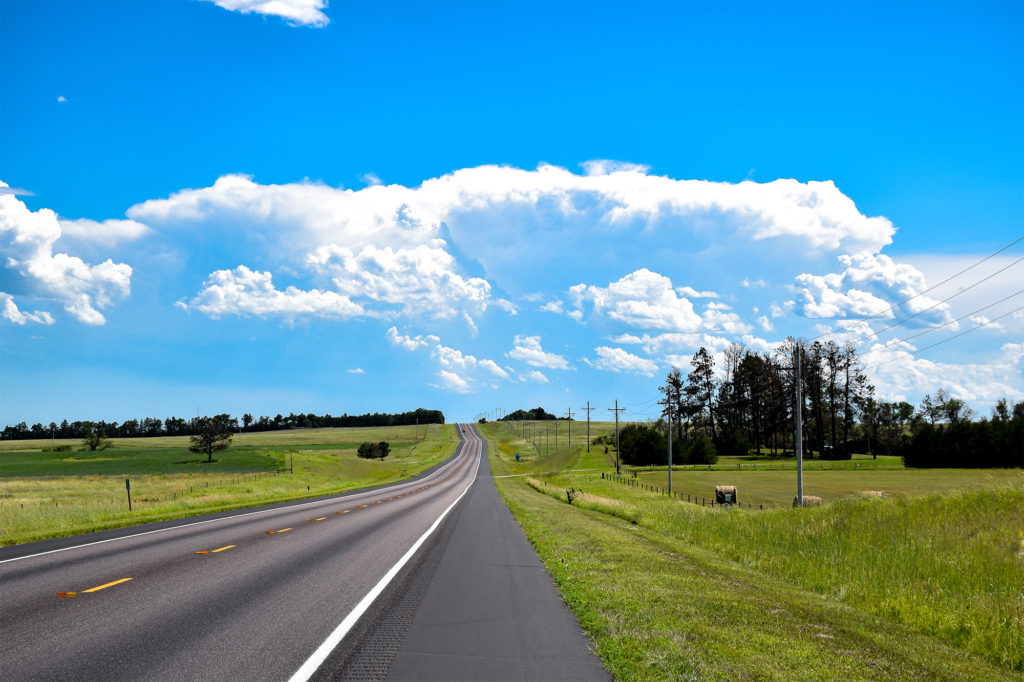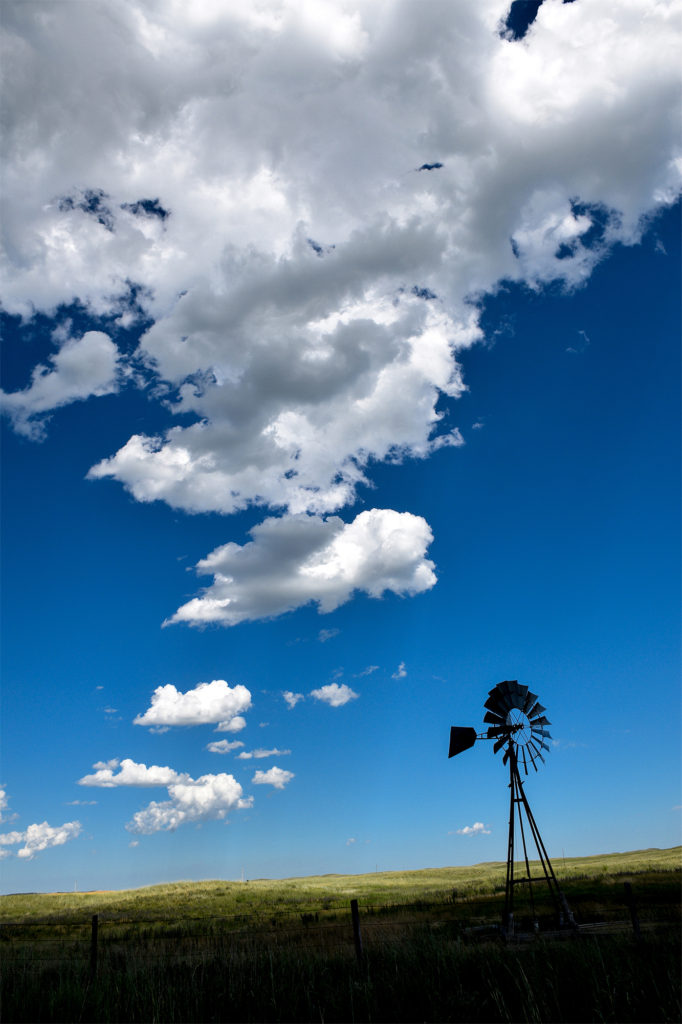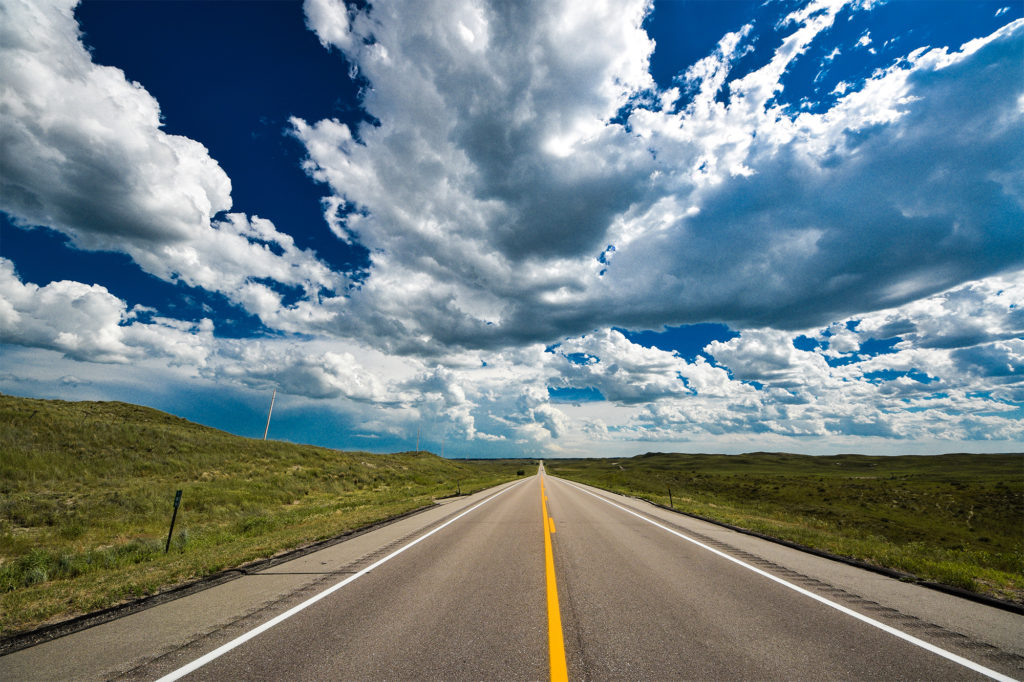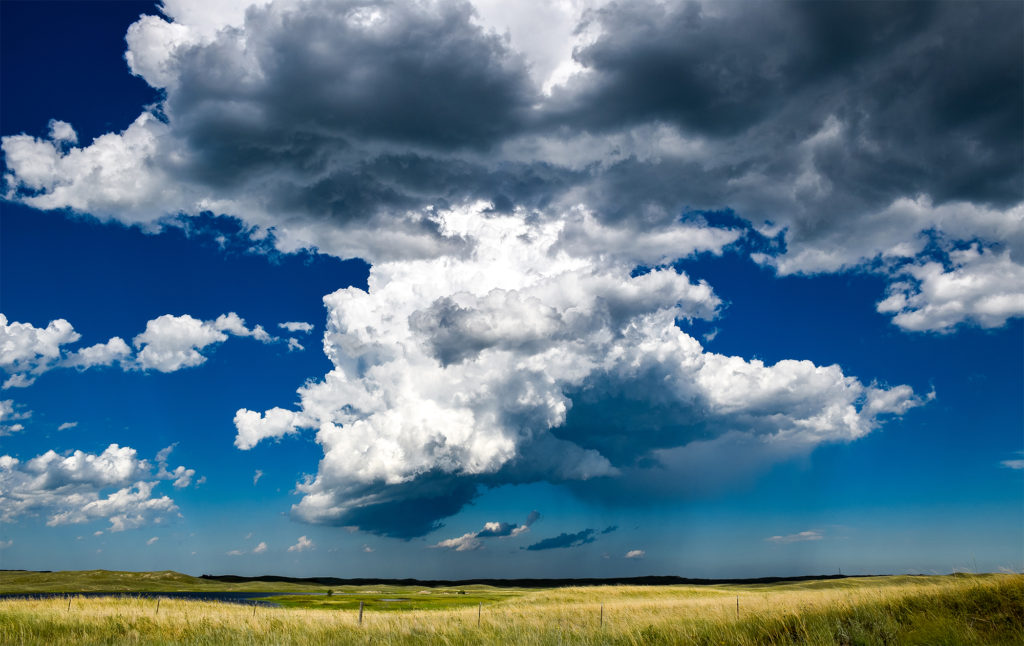1.
Today, I am not in a hurry.
There is no race. No deadline. No urgent press that compels me forward. No one is waiting. No one depends upon news I might bring.
There is just this road in front of me. Two lanes, one leading north and one leading south. They head down a prairie hill and then over a rise. Fields on both sides. There are clouds on the horizon, but here, at the intersection of I-94 and US Highway 83 in eastern North Dakota, at the Cenex gas station where I’ve stopped to buy gas and coffee, the morning is bright and warm.
Small rocks jump and skitter around my boots. There is a deep rumble, the kind that resonates more in the bones than in the ear, and smoke in the air. An eighteen-wheel tractor-trailer leaves the station. The driver waves to me as he pulls out. We’ve spent the last few minutes talking about gas station coffee—the heavenly as well as the hellish, from Key West to Moose Jaw—and laughed when our travels and tastes aligned. Good friends already.
There is a promise of thunderstorms this afternoon, some possibly severe. I have a map in my car, a printout from the National Severe Storms Lab in Norman, Oklahoma—the Day 1 Convective Outlook. This is the map that predicts where the air will rise, where it will rise strong and fast enough to produce storms, thunder, tornadoes. The risk for today, here, at this intersection and heading south, is “enhanced.”
I know I could turn on the radio, the cell phone, the computer, spend my day chasing clouds. That would certainly be a thrill, my Jeep fast down gravel roads and then tarmac, hoping to catch a glimpse of a Titan. That was the plan. And I know if a darkening cloud comes my way I will not turn from the meeting. But standing here, I have suddenly changed my mind. My goal, this day at least, is no longer the chase. My goal is to slow, to settle, to be patient enough to see where I am instead of racing to where I imagine I might want to be.
2.
There are different types of blue highway dreams. One is the rocket. Imagine a very fast car—in my mind a jet black Mustang—and the everlasting twilight of either dawn or dusk. An ominous cloud somewhere in sight, lightning and the bass of distant thunder, but the pavement is dry. If you were standing by the roadside you would hear little more than a Doppler whisper, a sudden sharp breeze and a blur. The sound would come later. Inside the car, Vivaldi or Liszt or Weather Report. Maybe Allman Brothers or John Williams. Fifth gear, out of six. The road turns and there is always the centrifugal force, a sideways strain in the tires, a sense of inertia wanting to break the hold. That’s the fun. Way too fast into a hill and the weight coming off the shocks at the top, a light into the sky.
The other is my Jeep. Old, beginning to rust. Wind noise even when the windows are tight. Instead of speed there is touch. Every pavement crack shakes knuckles and thighs. There is intimacy instead of speed. Smell and taste as much as sight and sound. Every road, every hole, every puddle is possible. Dust gets into the car and settles on your cheeks. This, too, is the fun.
3.
US 83 is The Road to Nowhere. It runs the 100th meridian, the working border between east and west, between arid and wet. It was the first paved road from Canada to Mexico. Highway guidebooks warn this road avoids every type of tourist destination. It’s called one of the loneliest roads in the United States.
There is a Siren in that promise. The name is enough to catch my desire.
At the Cenex station, where they sell bait along with gasoline and hotdogs, semi-trucks line up in the diesel bays, filling their tanks. I have a full tank of gas, a candy bar, a coffee, and a bottle of water. What more could a man ask for to hit the road?
I am heading south. I am in no hurry now but I do have a destination. With luck, this day will end in North Platte, Nebraska. After that, Tulsa, Albuquerque, a visit with family in Phoenix, then Denver, then a turn toward home. I had a plan, a wish for skies I want to see. But now I plan to follow whatever interests present themselves. What I am looking for is that sense of expanse. That sense of openness. Above me, the tremendous right now prairie sky.
There are places in the Dakotas where you crest a small rise and you see the road heading needle straight off into the distance, a single tree on the west side of the road. Grasslands or crops head for every horizon and for some reason you begin to think about survival. You begin to think about: could I make it if the car broke down? Where would I go? Start thinking about blizzards and extreme heat. It’s not exactly fear.
South of town, I pass an impossibly bright red barn behind a field of wheat already turned golden brown. I pass corn and cattle. The landscape rolls. Although I cannot see it, the Missouri River is a short distance to the west. I pass silver grain bins. Red-winged blackbirds on fence posts. Red-tailed hawks hovering in the sky. I pass old, weathered barns. Pass fields of soybeans. A lone woman paddles a canoe on a good sized prairie lake.
Already, just a few miles down the road, the most impressive thing is a sense of openness, of space. A sense of isolation and far-away-ness. This is a landscape open to imagination. There is no noise here. No billboards. Few highway signs. Few distractions other than clouds and the waves of other drivers. Few distractions other than trying to place this huge picture in the same frame as geology, biology, history, atmospheric rumble, and spark.
A sign tells me today’s fire danger is extreme. If this is the road to nowhere, I want to know where nowhere is.
4.
A road trip is always three things. Anticipation. Curiosity. Hope.
It can be a great many other things, too. A road trip can be danger, peace, romance, sex, rejection, clear sky, dust-choking, high-speed, broken axle, lonely road, traffic jam, blister hot, freeze to death, violent, rude, religious, forget yourself, know yourself, where the hell am I fun. It can be bad hotels and white terry-cloth robes. It can be a cheeseburger in a small town diner that reaffirms your relationship with God, whatever that relationship may be.
I am old enough now to know that anticipation and hope are my bedrock modes. I am an optimist—it’s simply how I see the world—so I rarely think about them. Curiosity, however, is the ever-present voice in my ear.
Coming into Linton, the landscape changes, quite suddenly, from small rolling hills to buttes, flattop hills, the kind of landscape you’d expect farther west. I have no idea why.
This part of North Dakota is still home ground for me. I know this ground is under the Central Flyway, the huge path for nearly 400 species of migratory birds, the Sandhill Cranes, Black-chinned Hummingbirds, Evening Grosbeaks, and Hermit Thrushes. And this ground borders the Mississippi Flyway, the path for Bullock’s Oriole, Hairy Woodpecker, Northern Cardinal, and Red-winged Blackbird. Add ducks and geese, cormorants and pelicans and egrets. Add sparrows and robins, too.
I know this ground was once under water. I am driving on the bottom of the Western Interior Seaway, a warm shallow ocean that ran from the Rockies to the Central Plains in the Cretaceous, home to Plesiosaurs and Mosasaurs and ancient sharks. Once the seaway receded and the land rose, this was home to T-Rex and Triceratops. Then the glaciers arrived. One reason eastern North Dakota is so level is that the Wisconsin Ice Sheet scraped it flat. One reason the land changes to buttes and badlands west of the Missouri River is the river marks the glaciers’ end.
But the buttes should not be here, I think. I pull over, make a note in my journal, call up the web on my cell phone. I learn I am standing on the Fox Hills Formation, sandstone and shale left by the Seaway. I am standing on what’s called Linton Ash, 500 million tons of volcanic ash in one 4,000 acre area, likely from volcanoes in Wyoming. And I am standing on the Hell Creek formation, a fossil-rich layer of sandstone left at the end of the Cretaceous, just before the asteroid hit the Yucatan.
What I cannot find, however, is the story. What happened, or did not happen, here, to allow these hills, these buttes, to remain? I can see the land this morning. I smile, knowing I have a question. In a month, or two, or several, I know I will hold some geology book in my lap after dinner and I will look up Linton, North Dakota. Those lingering questions, and the discovery of a possible answer, are a deep source of joy. There is always a story.
5.
I do not expect Lawrence Welk.
Nearly 11:00 a.m., just outside of Strasburg, North Dakota, I pass a sign that tells me I am two miles from the birthplace of Lawrence Welk. I smile, old memories of watching the show in a basement TV room with my parents, brothers and sister, the bubble machine and pastel suits and dresses, odd colors in the early days of color broadcast, polka music, waltzes, but I have no intention of stopping. Then I romp on the brakes. I am not in a hurry. There is no way I am going to pass the birthplace of Lawrence Welk.
I turn off 83. A single lane gravel road leads past corn and open fields. A simple wooden sign at an intersection points to Welk Farm, a turn to the right. The road ends at a grass parking area—one other car already here—a handful of farmstead buildings on the shore of a small lake. I get out of the Jeep.
A lady sticks her head out of a building and welcomes me to the site. I enter her office and learn it costs $5 to take a tour. I hand her my debit card and she tells me the site is cash only. I do not have cash, yet she tells me I can tour the grounds and take whatever pictures I wish. An elderly couple sits in the office, waiting for the official tour to begin, even though they are the only people here. They hold hands, looking a bit overwhelmed.
There is a red barn, a mannequin of a boy holding an accordion in the hayloft door. He looks wistful, dreamy, perhaps romantic. There’s a buggy house, a grainery, a blacksmith’s shop, a summer kitchen, and a privy. There is also the home itself, an outside staircase to get from the first floor to the second, even in winter. The buildings are all painted white, except for the barn and a windmill. The lake is calm. Brown and green fields of hay and corn seem to promise a good harvest.
But there is a secret here. Local knowledge, though I doubt it’s on the tour. Lawrence Welk hated this farm. He hated it deeply. He left when he was 21. And once he left, he never came back. Not even once.
6.
When I cross into South Dakota, the landscape still absolutely, tremendously open, the sky now cloudless and huge, I pass a farmer who, having cut hay on the roadside shoulder is now swathing it into long paths, pulling an eight-bladed hay rake behind a small tractor. I pass him thinking his row of cut hay would end at the next driveway or turnout. Instead, it goes on for miles, sometimes doubling into two rows. I know he will drive this again with a bailer. Then again, to collect the bales. Zipping along at nearly seventy miles per hour, the path seems endless to me. At his ten miles per hour it must be Zen. Or madness.
7.
The mind does wander. That’s the whole point.
I have a message from Daryl, a friend, a meteorologist back in Fargo. “The atmosphere is pretty well capped at the moment,” he writes. “There is cold air on top of the warm, on top of the surface heating, that’s keeping it from rising. But if the surface heating can get strong enough to break through that cap, then it could be really something.”
In Herreid, South Dakota, I pass a plain building. Brown siding, a bit of brick, steel door, three windows. The sign tells me this is the Herreid Fitness Center—and Library. Herreid is a very small town and I imagine the Fitness Center is two, maybe three treadmills, one of them quite dusty. An elliptical machine. A collection of weights. And Library? Is fiction between the rowing machine and the bathroom?
This sounds condescending, but that’s not what I mean. Not what I mean at all. I have this vision of people who know each other well, talking about Proust on hot summer nights as they run. I have this vision of people debating the merits of nominees for the National Book Award as they count repetitions. I have this hope that some old volume of poetry gets left on the panel of a treadmill and someone else comes along, not really thinking of poetry at all, but then cannot stop.
I have no idea who visits the Herreid Fitness Center and Library, and that is exactly the point. I know the books could just as easily be discarded encyclopedias, very old romance novels, cheap science fiction, donated collections of Popular Mechanics and National Geographic. As my Jeep gains speed, I know I could stop. I could investigate. I could answer this question. But this wondering has its own merit. Everything is possible.
Then I pass a sign for the Herreid S&S Winery. I do not see rows of grapes in a field, so I pull over and look at their Facebook page. Grape Wine. Rhubarb Wine. Apple Wine. Plum Wine. Chokecherry Wine. Potato Wine. Onion Wine. The owners’ comments seem open, friendly, welcoming. We have new flavors! Come see us and you can drink more! Wine specials still on. Have Apricot and Peach ready now.
This could be really something.
8.
In Agar, South Dakota, two grain elevators stand side by side. The architecture is identical, though one elevator is new, one clearly not. On the south side of town, the type of sign I have come to love stands in front of a wheat field already turned brown.
Welcome to Agar – Home of the 1977 State “B” Track Champions – Coach Shafer. Jerry Mikkelsen. Tim Jost. Jay Mikkelsen. Bill Lytle. Marty Cavanaugh. Scott Wagner. Kevin Nystrom. Bob Logan. Shawn Schreiber.
If these athletes were 17 years old in 1977, they are 37 years old now. I am sure they are gone, dispersed to Minneapolis, Chicago, Des Moines, Hong Kong. I’m sure one or two farm nearby. But the sign is large, strong, well-maintained. It’s a sign for those who remain and those who travel through. Once there was glory. Here.
9.
Coming into Pierre, South Dakota, the state’s capital, the road becomes four-lane, freshly tarred and graveled. I hear the rocks in my wheel-wells. There are subdivisions and billboards and traffic lights. Chain restaurants. Chain hotels and supermarkets and auto repair shops. I’m sure it’s a nice little city, but I cannot get through it quickly enough. There is too much here, not enough room for the horizon.
I cross the Missouri River, climb a small rise, pass a tall grain bin that’s been dented in, folded by what I imagine was some storm. Pierre becomes Fort Pierre on the west side of the Missouri and the possible stories begin again. I cross over the Bad River. Somebody had to give it that name. Bad River.
Highway 83 remains a four-lane divided highway, though outside of town it has the traffic of Mars. I suppose there is a reason—a good road to connect the capital with I-90. That would make sense. But when it cuts through the Fort Pierre National Grasslands, the road seems like an endless invitation to wonder. From cosmic dust to snowball earth to Sicangu Oyate to now, what is this place? Who has been here? What storms? What heartbreak? What joy?
Sitting in my Jeep, I am suddenly reminded of a scene from an old movie. And not a prairie movie, either. No western. No Dances with Wolves. What goes through my head is a scene from The Time Machine, the old version, made in 1960. H. G. Wells sits in his machine, heading toward the future, slowly at first. He watches the sun, the sun he knows, transit the sky. Then the moon. Then the sun. Double speed. Then triple speed. Faster. He watches the candles in his laboratory burn away, plants flower and then wither, seasons change. The look on his face is simple, profound, curiosity and wonder. He can see the movement of time.
This place is certainly remote. By chance, the sun is directly in front of me, directly over the road, held in a deep blue sky with a few cotton ball clouds, and I am ferociously impressed. Tremendously impressed by the open space. Treeless. Slightly rolling. This is the feeling of both humility and membership. Not just my town, my prairie, my ground. My planet.
Highway 83 joins Interstate 90 for a small stretch of west-river distance and as I merge onto the road the speed limit goes up to eighty and I am passed, immediately, definitively, by a Corvette. Then an eighteen-wheel truck. Then a sedan. This is the road to the Black Hills, Mt. Rushmore, Wall Drug, Devil’s Tower. Billboards. Fast food. I turn on the radio for the first time today. Classic rock, then an ad for a hardware store. Every word is an invitation to be someplace else.
When the exit for 83 South arrives, I turn off the radio and roll down the windows. In the fields I see hay bound up into bales. The air is summertime dusty and hot. The road, undivided, heads off into hills.
10.
Clouds form in the southern distance. Thermals breaking through the cap, I think. Vertical columns beginning.
I cross the White River and the road becomes fun. The road begins to twist and turn, rise and fall. Winding into the hills, the road follows valleys and then rises. I get to play with the gearshift. I get to turn the wheel. I pass sagebrush for the first time today, which makes me inexplicably happy.
When I cross into Nebraska, I enter Cherry County and, if you chase storms, you know Cherry County. It’s called Chaser’s National Park. There is no real park, of course. And there really aren’t that many storms here. But if you’re chasing storms, for one reason or another, you find yourself passing through Cherry County, Nebraska, a lot. It’s the path from one storm to another. But you only know about it if you’re racing through.
And as luck would have it, there is this storm in front of me. I can see it building. A look at the radar on my phone tells me the storm, just one cell, is near the town of Thedford, seventy miles away. It’s not a whopper, but the radar is red. A downpour. A gully-washer. Probably some wind and a bit of hail. Certainly faces pressed to windows to watch the fury and swirl.
I will admit the cell is alluring. There is a part of me that wants to step on the gas, hurry through every turn and intersection, get myself into the winds. There is something about being a witness, to see the scale of the energy released. To be that close to chaos and survive.
11.
There might be storms, but I will not see them. A sign says “check brakes” and shows the universal picture of a truck going downhill.
Check brakes? Here?
Suddenly I am in a pine forest. Suddenly, yes, the road is going downhill steeply. I upshift. The air smells cool.
The radar on my cell phone begins to light up. The cap has been broken. Hail. Thunderstorms. All to the south of me. A few beginning to appear back north, too. Back toward home. The road comes out of a small river valley and passes through the town of Valentine. I can see the Thedford storm over the rooftops and traffic lights.
South of Valentine a sign points me to a historical marker. Stop, I think. Read the sign. Today, I am not in a hurry. I cross a bridge over the Niobrara River and turn right, loop back toward the water, to an older bridge. The older bridge is the historical event. The Bryan Bridge, named in honor of Governor Charles Wayland Bryan, was voted the Most Beautiful Steel Bridge, Class C, in 1932 by the American Institute of Steel Construction. According to the marker, “This arched cantilever truss bridge, connected in the center with a single pin, is the only one of its kind in the United States…This particular design was chosen because it was aesthetically compatible with the surrounding environment of the Niobrara River Valley.”
Designed by Josef Sorkin, a Russian immigrant, the bridge is on the National Register of Historic Places. But from the roadway, the bridge is nothing special. I walk out to the center. One lane each way, double yellow center stripe, modern steel guardrails. To the east I can see the concrete pillars of the more modern bridge that carries Highway 83. Beyond that, the steel girders under a bridge that used to carry a railroad but now carries the Cowboy hiking trail.
I cannot see the cantilever trusses, so I finish the loop and stop the car at the start of the newer bridge on 83. The river itself, summer brown and shallow, meandering in a small green valley, is idyllic. There should be the evening buzz of cicadas, I think. A lemonade stand. Someone selling sweet corn.
The Bryan Bridge is classic. An arch over the river’s center. In 1932, Franklin D. Roosevelt won the presidential election; the Great Depression was four years old. William Faulkner published Light in August; Shirley Temple appeared in her first movie. Hitler refused Hindenburg’s offer to become Vice Chancellor; there was another run on the banks. New York defeated Chicago in the World Series; unemployment in the United States reached twenty percent—fifteen million people could not find a job. Greta Garbo starred in Grand Hotel; Johnny Cash and Elizabeth Taylor were born. Popular songs were “Brother, Can You Spare a Dime,” “Night and Day,” “April in Paris.” And here, in western Nebraska, someone decided that this bridge was the most beautiful Class C steel bridge of the year. It’s humbling and beautiful to see.
12.
In late July, the Nebraska Sandhills are a soft, encompassing green. I stop to take a picture of a windmill.
I stop to take a picture of a pretty cloud.
When I finish and put the car in first gear, my tire spins and digs a hole in the soft ground. I get out and look at it. You’re kidding, I think. Then I smile. I know the Sandhills are their own ecosystem, a type of scrub desert, grasses holding together sand dunes that can reach 330 feet tall. I know somewhere below me is the huge Ogallala aquifer. I know most of the Sandhills are considered intact natural habitat, having never been plowed. And I know they call to my heart.
I think about what this would mean if I were driving something else. What if I were really stuck? Put down roots. Stay a while. I’m on the road to nowhere, and perhaps I’ve arrived. What if I were to watch the sun and the moon arc across this sky?
I put the car in four-wheel drive and the Jeep easily pulls away. Still, I think.
North Platte is an easy distance in front of me. The country’s largest railyard is there, with its own observation tower. The Pony Express trail runs through there too. I’ll see those tomorrow.
Today, however, I am not in a hurry. It begins to rain.



